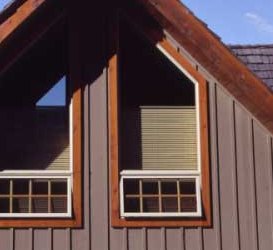
Figure 1 - Wood siding
Your choices for a finishing product are a wood stain or paint and although that sounds relatively simple, the manufacturer’s of stains and paints have decided, for whatever reason, to confuse the issue by labeling many outdoor paints as a "solid stain".
Stain:
A stain is a product that has the consistency of water and is designed to penetrate wood fibers, as shown in Figure 2. Because it actually penetrates the wood fibers it cannot peel, blister or flake. It is important to note that a stain can only be applied to bare wood. If the wood has any other product on its surface or within the fibers, it must be sanded off, down to bare wood in order for the stain to have access to the wood fibers.

Figure 2 - Wood with and without stain
Stains allow the natural beauty of the wood grain to show through the pigments in the stain. Blemishes such as knots in the lumber will also be visible.
Wood that is stained will have not have a uniform color, as the stain will not penetrate all of the wood fibers to the same degree.
The sample colors that you see at the paint store are only relevant if the wood is of the same species, as different species of woods have different underlying natural pigments and the blend of the natural pigments in the wood with the stain will produce a combination color effect.
In other words, using a light colored stain on a dark piece of lumber will not make the lumber a lighter color!
Paint:
Paint adheres to the surface of the wood or any other product. It does not penetrate the woods fibers. It creates its own unique surface layer, as shown in Figure 3. In fact, if you use a precision measuring device you will find that wood covered with paint is thicker than the piece of wood without the paint.

Figure 3 - Wood with and without paint
Because paint sits on top of the surface of the wood rather than penetrating the surface of the wood it can flake or blister. This happens in areas where the paint has not adhered properly to the surface of the wood. This can be caused by dirt or grime that was painted over, moisture within the wood that tries to escape, paint shrinkage or a number of other chemical reactions.
The advantage to paint is that it covers any blemishes or repairs that are visible in the wood. If a piece of siding became damaged and was replaced with a new piece of siding, the natural pigments in the new siding would not match the older material and hence if you applied a stain the new piece of siding would standout against the older siding. With a high quality exterior paint, any blemishes or repairs will be hidden from view.
Another advantage to paint is that with the new color pigments and additives you can choose almost any color that you can imagine, and you will be able to see the finished color at the paint store as the color of the wood will not have any effect on the paint color.
Solid Stain:
Basically solid stain is paint. It does not penetrate the wood fibers. It adheres to the wood in the same manner as paint and sits on top of the wood’s surface and hence it can blister or peel.
Summary:
The easiest way to determine if you have stain or paint is to look at the product. If it has the consistency of water, it is a stain. If it has the consistency of paint then it is paint. A rose by any other name will still smell like a rose and the same applies to paint. You can call it a stain, but if it has the consistency of paint, that is exactly what it is!
